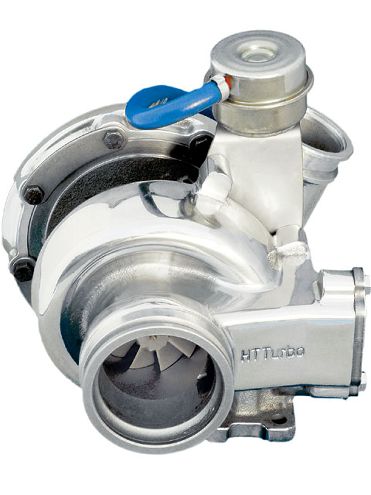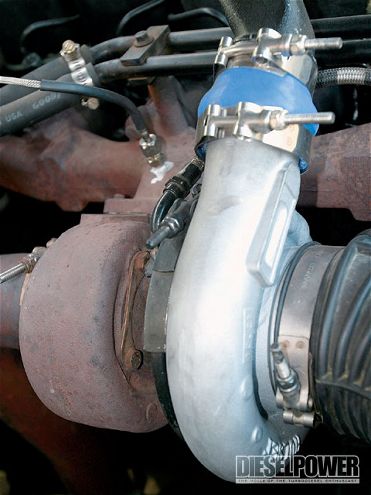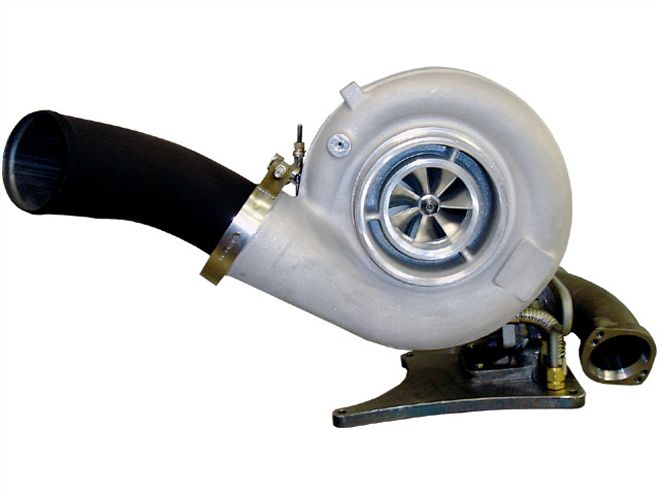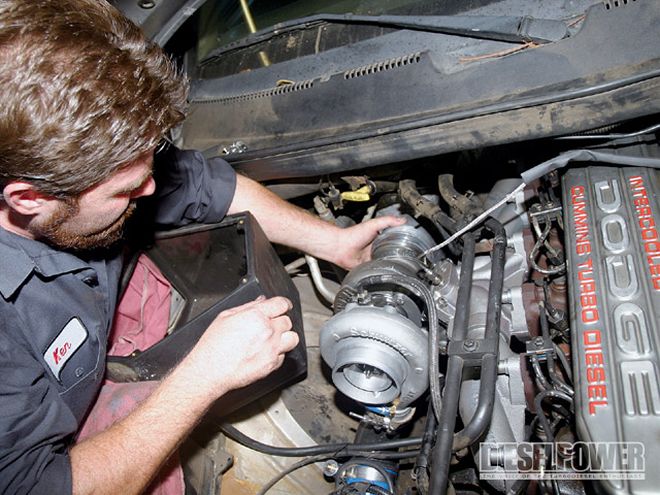
| turbocharger Basics dodge Turbo Diesel
One of the more difficult technical aspects of diesel performance is choosing a turbocharger. If you put enough fuel through a diesel engine, it's going to run up against a point where the stock turbocharger becomes very inefficient. The stock turbo can even overspeed and the compressor wheel can explode, sending metal into your intercooler and engine. Also, having a turbocharger that is mismatched to your engine can cost you horsepower, and we all like horsepower.
So what's the right turbo to choose? Well it depends on many different factors. For racing engines the answer is simple: as big a turbo as you can spool, or that the rules will allow. For a street truck, it is a little more complicated. Drivability has to be a concern. It's no good to sit there waiting for your turbocharger to spool while your buddy passes you, so on a street truck it's better to be a little smaller than too large.
Taking StockFirst off, you have to decide if you need a new turbocharger. Cummins and Power Stroke engines can support 350 to 400 hp to the wheels with a stock turbocharger. Duramax engines can hit a hot and smoky 500 hp on a big tune with a stock turbo. So if you're an intake and exhaust type of guy, you probably don't need a new turbocharger. If you're shooting for 500 to 800 hp (or if you tow), then it's time to start shopping. In the case of an overfueled stock engine (lots of black smoke), buying a new turbocharger will add horsepower, lower exhaust gas temperatures, and be capable of supplying higher boost pressures without risk of failure.
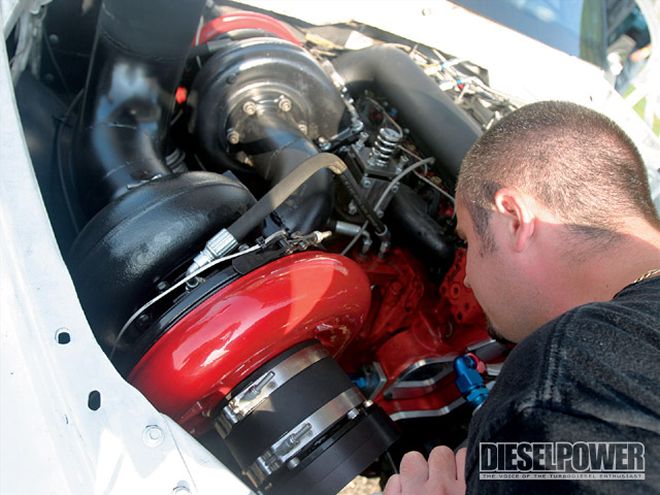
| Almost all the companies we spoke with indicated consumers usually want to buy a turbocharger that is way too large for their truck. Do you really need a turbo that's larger than your head on a street truck? The answer is no, you don't. Custom turbo setups like the one on Meacham Evins' drag truck run about $5,000 to $10,000 and feature turbochargers larger than 100 mm in inducer diameter, but they have no place on a diesel that makes less than 1,500 hp or spins less than 5,000 rpm.
Weights And MeasuresWhen we're talking turbocharger sizes, the most commonly referred to measurements are the compressor wheel's inducer diameter, turbine wheel diameter, and turbine-side housing ratio. All of these numbers affect how the turbo will behave. Stock turbochargers usually have large exhaust housings, large-diameter turbine wheels, and smaller compressor-side inducers. For instance, an HX35 turbo from a 5.9L Cummins measures somewhere around 54/69/14, which means it has a 54mm-inducer compressor wheel, a 69mm-inducer turbine wheel, and a 14cm2 exhaust housing. The size of the exhaust housing determines how quickly the turbocharger will spool up, but having too small of a housing can create high drive pressures (think of it as boost on the exhaust side) which is hard on engines, turbochargers, and exhaust hardware. Non-wastegated turbochargers often have larger exhaust housings to ensure the turbo's drive pressure remains in an acceptable range, even at maximum engine speed and fueling. A popular aftermarket turbo might be in the 64/71/14 range if it's not wastegated, while a quicker-spooling 64/65/14 (notice the small turbine diameter) will need to be wastegated, or high drive pressures, high EGTs, and possible turbo overspeeding will be the result.
It's The Engine, Not The TurboWhen it comes to turbo sizing, the engine design dictates the type of turbo to use. For instance, larger turbochargers in the 66mm to 71mm compressor wheel inducer range might not even start to spool until the engine reaches 2,200 to 2,500 rpm. If you're putting this turbo on a stock engine that makes power at 2,800 rpm, you might be in trouble. After all, a few hundred rpm does not make for a very usable powerband. If you have an upgraded camshaft, ported head, and enough fuel to turn your engine 4,500 rpm, then having your turbo spool above 2,500 rpm might not be a big deal. An engine that is spinning faster will also require more air, so a high-rpm engine will also need a larger turbocharger for that reason.
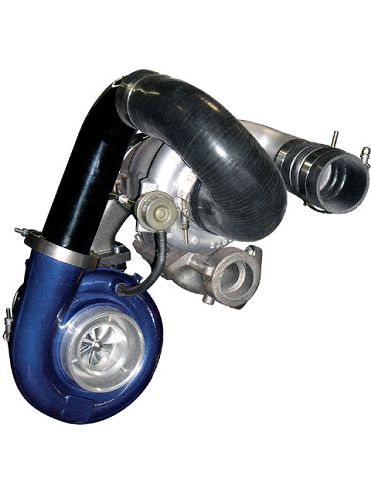
| A set of compound turbochargers, like this setup from ATS, is a good choice for performance and drivability. The smaller turbo is used to spool the larger one, and the pressure ratio requirement is split between the two turbochargers. Oftentimes the stock turbocharger can be used for the smaller turbocharger, which also helps offset the cost of such a kit.
Turbos And TowingIf you tow heavy loads (10,000 pounds or more) a larger turbo might be a good idea. Why? Towing puts the engine under a tremendous load, which means exhaust gas temperatures need to be a priority. An aftermarket turbocharger (or better yet, two compound turbochargers) will flow more air even at part throttle, resulting in lower EGTs across the board. With a diesel engine, running richer will make more power, but leaner will be better on exhaust gas temperatures. If you're adding more fuel to your truck to tow up hills, make sure you balance it out with more airflow.
Size MattersA turbocharger of a given size will behave differently on a 7.3L Ford Power Stroke compared to a 5.9L Cummins. Why? The Power Stroke is a larger engine, so more exhaust gases are produced, which means more energy is available to drive the turbocharger. It's for that reason that the 7.3L Power Strokes and 6.6L Duramaxes come with larger turbochargers from the factory. If you're looking for an engine that will have a wide usable powerband, use a medium-sized turbo on a large, high-rpm engine.
Two Turbos Are Better Than OneOnce a turbo starts to produce boost, it causes the engine to produce much more power, which in turn creates more exhaust drive pressure to spin the turbo. For this reason, having a compound turbo setup with one smaller turbo and one larger one, is very beneficial. Having one turbo blow into the other is also a very good way to reduce the work cycle of the turbocharger. Two turbos, producing 30 psi of boost each, will make 60 psi worth of pressure when combined, which is a lot easier than getting one turbo to produce 60 psi. However, going to a set of twin turbos results in very high intake air temperatures due to the raised boost pressures, so water injection, nitrous, or a good intercooler are highly recommended. Installing a second turbocharger in the engine bay can be a real nightmare and requires complex plumbing, which is why compound turbo kits are usually so expensive.
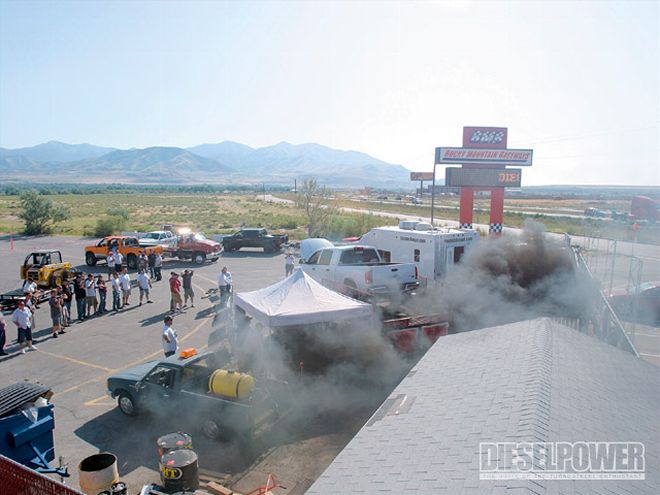
| Trucks with larger injectors and huge turbos usually have poor street manners--they're smoky, and slow to spool. Jorge Alfonso, an '07 Diesel Power Challenge competitor, had trouble spooling his mammoth 71mm-inducer turbocharger at high elevation (notice all the black smoke). If you're willing to sacrifice street manners in the name of power, a turbocharger this large can be well worth the effort. Since our event, Jorge has made 900 hp on diesel fuel, and 1,300 hp with nitrous.
Why Wastegate?A wastegate is a device that allows the exhaust pressure coming out of the engine to be diverted around the turbine wheel in the turbocharger. Bleeding off the exhaust drive pressure allows you to control the turbo's speed and run a smaller turbo exhaust housing, without choking the engine or overspeeding the turbo. Using a turbo with a wastegate allows you to tune the turbo, gives the engine better response, and in some cases, allows you to run a larger turbocharger.
Most turbochargers have internal wastegates, which are fine for street applications, but they're limited by how much exhaust drive pressure they can divert around the turbine wheel. If you're looking to use a lot of nitrous, sled pull, or drag race competitively, an external wastegate is good because it attaches between the exhaust manifold and the turbocharger and can divert more drive pressure.
Power Stroke and Duramax owners have it tougher because of the placement of their turbochargers, which makes wastegating more difficult. For the Duramax and Power Stroke guys, upgrading to larger, but quick-spooling turbos (which are usually pretty expensive), is their best bet.
About The AftermarketStock turbos can only do so much. If you're trying to get 50 pounds of boost out of a turbo designed to operate at 20 psi, expect the parts to start flying. The diesel performance industry has embraced these problems by selling upgraded turbos with wastegates, modified compressor and exhaust housings, and different compressor wheels and shafts. If you're the type of person who likes some bling, polished compressor housings are usually available. If you're in it for reliability, improved oiling, ball-bearing supported shafts, and water-cooled turbochargers can be had as well.
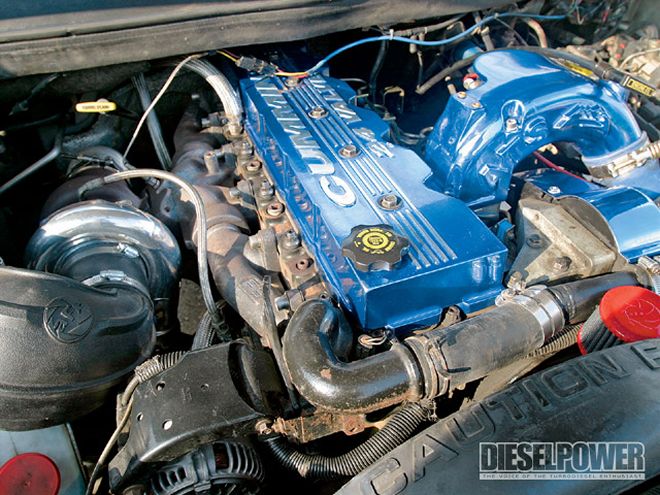
| Andy Thomas used a 66mm-inducer Silver Bullet turbocharger from Industrial Injection to make almost 600 hp at the wheels. Notice that Andy has also upgraded the intake horn, added head studs, and used an aftermarket exhaust manifold. When changing turbochargers, don't forget about all the other hardware associated with the power increase. Intercoolers (to help cool the added air from the upgraded turbocharger) and exhaust downpipes (to help the added exhaust gases exit the engine) are some of the more commonly upgraded parts when stepping up to a larger turbocharger.
Time To ChooseTo make things easier, we've included a chart for street truck turbo selection, and an explanation of compressor maps (see pg. 46). Even with this information, you still have to be honest about how you're going to use your diesel. If you're looking for a bit more performance but still want to tow or drive your truck daily, we'd pick the smaller side of the turbo spectrum. If your engine has had head or cam work, and you plan on sled pulling or drag racing your vehicle, we'd go bigger. Remember, at the higher power levels (600 hp and up) plan on trying to turn some rpm to help those big chargers spool. Also, don't be afraid to call and talk to all of the different turbo manufacturers before you make a decision.
Compressor MapsProbably the most important information you can acquire about a turbocharger comes on a little piece of paper. A compressor map is a chart that shows turbocharger efficiency ranges, surge lines, and maximum speed. It's also one of the best ways to show why you'll need an aftermarket turbocharger for your hopped-up diesel.
First comes first though, we'll teach you how to read a compressor map. On the left side of the chart extending upward is the turbocharger pressure ratio, also known as boost. A 2:1 pressure ratio means twice atmospheric pressure. Atmospheric pressure at sea level is roughly 14.7 psi, so a 2:1 pressure ratio would be: (atmospheric pressure x pressure ratio = turbocharger air pressure - atmospheric pressure = boost pressure) or (14.7 psi x 2 = 29.4 psi, 29.4 psi - 14.7 psi = 14.7 psi).
The second aspect of the chart is airflow, which involves engine size and engine speed. Normal engines are about 85 percent efficient, so theoretical engine airflow can be calculated as: (displacement x engine rpm / 3,456 x efficiency) or, in the case of a stock 5.9L (359ci) Cummins spinning 2,800 rpm, the engine would need a theoretical airflow of: (359 ci x 2,800 rpm / 3,456 x 0.85 = 247 cfm.)
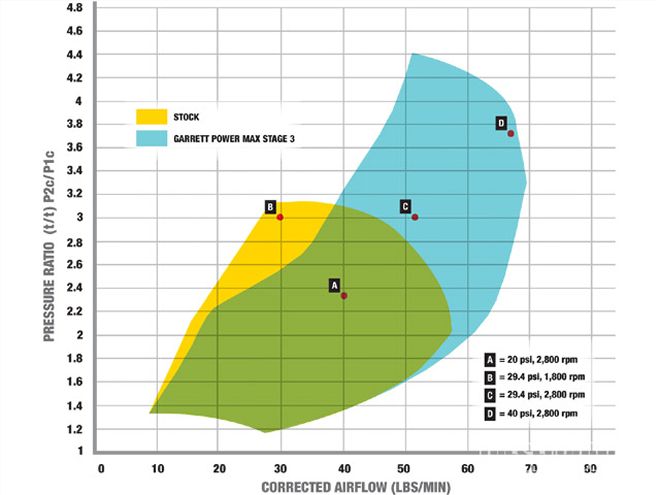
| Compressor Map
Now comes the step that puts it all together. Since the maximum boost most 12-valve Cummins will make is about 20 psi (which is a 2.36:1 pressure ratio), we have to multiply 247 cfm by the 2.36:1 pressure ratio, which gives us 583 cfm. Most compressor maps come in a pounds/minute format, so we must multiply 583 cfm x 0.07 to get pounds/minute, which means at 2,800 rpm, at a 2.36:1 pressure ratio, the turbocharger will be flowing 40.8 pounds/minute. If we plot 2.36:1 pressure ratio and 40.8 pounds/minute on our chart, we can see it falls well within the efficiency range of a stock Cummins HX35 turbocharger.
When a diesel is under a high load (such as towing) the turbocharger will often spin faster and create more boost because the engine is creating more exhaust heat. Plot B is an example of an HX35 having to produce 29.4 psi (a 3:1 pressure ratio) at 1,800 rpm (which is close to the engine's torque peak). If we take this same setup and ask it to make 29.4 psi at 2,800 rpm at the dragstrip (plot C), you can now see that we've reached the limits of the stock turbocharger. Running an HX35 turbo at this level will be very inefficient (about 50 to 55 percent instead of 70 percent) and the turbo will be in danger of overspeeding. The lower efficiency of the turbocharger will also heat up the air more, resulting in a power loss compared to a properly sized turbocharger.
Speaking of properly sized turbos, plot C falls well within the efficiency range of the PowerMax Stage 3 Garrett turbo. In fact, the Garrett is safe all the way to 40 psi at 2,800 rpm (plot D). Since the turbocharger is still well within its efficiency range, the air will be denser and cooler, and will therefore make more power. Note that if the engine was any larger (say a 7.3L Power Stroke instead of a 5.9L Cummins) or spun any higher (Duramax) then a larger turbocharger would be needed to satisfy the added airflow requirement.
COMPRESSOR INDUCER DIAMETER DESIRED
HORSEPOWER CUMMINS DURAMAX POWER STROKE {{{300}}} hp stock stock stock 400 hp 60-62mm stock 64-66mm 500 hp {{{62}}}-64mm stock 66-71mm {{{600}}} hp 64-66mm 66-68mm 66/90mm* 700 hp 66-71mm 71-75mm 71/100mm* 800 hp 64/80mm* 66/90mm* N/A
Note: All numbers diesel fuel only *= denotes a compound setup
Since many diesel owners shoot for a certain power level with their rigs, we've included this handy-dandy chart as a guideline to choosing the correct turbo. There are many factors that contribute to how a turbocharger will react, including gearing, weight, torque converter stall speed, and engine speed, as well as driving style. If you expect a quick spool-up and good street manners, go smaller rather than larger on the chart. If you want to spin the engine faster and are looking for power at the sacrifice of some drivability, go larger rather than smaller. And finally, if you're towing all the time or looking for lots of horsepower, nothing beats a set of twin turbos.
 | turbocharger Basics dodge Turbo Diesel
One of the more difficult technical aspects of diesel performance is choosing a turbocharger. If you put enough fuel through a diesel engine, it's going to run up against a point where the stock turbocharger becomes very inefficient. The stock turbo can even overspeed and the compressor wheel can explode, sending metal into your intercooler and engine. Also, having a turbocharger that is mismatched to your engine can cost you horsepower, and we all like horsepower.
So what's the right turbo to choose? Well it depends on many different factors. For racing engines the answer is simple: as big a turbo as you can spool, or that the rules will allow. For a street truck, it is a little more complicated. Drivability has to be a concern. It's no good to sit there waiting for your turbocharger to spool while your buddy passes you, so on a street truck it's better to be a little smaller than too large.
Taking Stock
| turbocharger Basics dodge Turbo Diesel
One of the more difficult technical aspects of diesel performance is choosing a turbocharger. If you put enough fuel through a diesel engine, it's going to run up against a point where the stock turbocharger becomes very inefficient. The stock turbo can even overspeed and the compressor wheel can explode, sending metal into your intercooler and engine. Also, having a turbocharger that is mismatched to your engine can cost you horsepower, and we all like horsepower.
So what's the right turbo to choose? Well it depends on many different factors. For racing engines the answer is simple: as big a turbo as you can spool, or that the rules will allow. For a street truck, it is a little more complicated. Drivability has to be a concern. It's no good to sit there waiting for your turbocharger to spool while your buddy passes you, so on a street truck it's better to be a little smaller than too large.
Taking Stock | Almost all the companies we spoke with indicated consumers usually want to buy a turbocharger that is way too large for their truck. Do you really need a turbo that's larger than your head on a street truck? The answer is no, you don't. Custom turbo setups like the one on Meacham Evins' drag truck run about $5,000 to $10,000 and feature turbochargers larger than 100 mm in inducer diameter, but they have no place on a diesel that makes less than 1,500 hp or spins less than 5,000 rpm.
Weights And Measures
| Almost all the companies we spoke with indicated consumers usually want to buy a turbocharger that is way too large for their truck. Do you really need a turbo that's larger than your head on a street truck? The answer is no, you don't. Custom turbo setups like the one on Meacham Evins' drag truck run about $5,000 to $10,000 and feature turbochargers larger than 100 mm in inducer diameter, but they have no place on a diesel that makes less than 1,500 hp or spins less than 5,000 rpm.
Weights And Measures | A set of compound turbochargers, like this setup from ATS, is a good choice for performance and drivability. The smaller turbo is used to spool the larger one, and the pressure ratio requirement is split between the two turbochargers. Oftentimes the stock turbocharger can be used for the smaller turbocharger, which also helps offset the cost of such a kit.
Turbos And Towing
| A set of compound turbochargers, like this setup from ATS, is a good choice for performance and drivability. The smaller turbo is used to spool the larger one, and the pressure ratio requirement is split between the two turbochargers. Oftentimes the stock turbocharger can be used for the smaller turbocharger, which also helps offset the cost of such a kit.
Turbos And Towing | Trucks with larger injectors and huge turbos usually have poor street manners--they're smoky, and slow to spool. Jorge Alfonso, an '07 Diesel Power Challenge competitor, had trouble spooling his mammoth 71mm-inducer turbocharger at high elevation (notice all the black smoke). If you're willing to sacrifice street manners in the name of power, a turbocharger this large can be well worth the effort. Since our event, Jorge has made 900 hp on diesel fuel, and 1,300 hp with nitrous.
Why Wastegate?
| Trucks with larger injectors and huge turbos usually have poor street manners--they're smoky, and slow to spool. Jorge Alfonso, an '07 Diesel Power Challenge competitor, had trouble spooling his mammoth 71mm-inducer turbocharger at high elevation (notice all the black smoke). If you're willing to sacrifice street manners in the name of power, a turbocharger this large can be well worth the effort. Since our event, Jorge has made 900 hp on diesel fuel, and 1,300 hp with nitrous.
Why Wastegate? | Andy Thomas used a 66mm-inducer Silver Bullet turbocharger from Industrial Injection to make almost 600 hp at the wheels. Notice that Andy has also upgraded the intake horn, added head studs, and used an aftermarket exhaust manifold. When changing turbochargers, don't forget about all the other hardware associated with the power increase. Intercoolers (to help cool the added air from the upgraded turbocharger) and exhaust downpipes (to help the added exhaust gases exit the engine) are some of the more commonly upgraded parts when stepping up to a larger turbocharger.
Time To Choose
| Andy Thomas used a 66mm-inducer Silver Bullet turbocharger from Industrial Injection to make almost 600 hp at the wheels. Notice that Andy has also upgraded the intake horn, added head studs, and used an aftermarket exhaust manifold. When changing turbochargers, don't forget about all the other hardware associated with the power increase. Intercoolers (to help cool the added air from the upgraded turbocharger) and exhaust downpipes (to help the added exhaust gases exit the engine) are some of the more commonly upgraded parts when stepping up to a larger turbocharger.
Time To Choose | Compressor Map
Now comes the step that puts it all together. Since the maximum boost most 12-valve Cummins will make is about 20 psi (which is a 2.36:1 pressure ratio), we have to multiply 247 cfm by the 2.36:1 pressure ratio, which gives us 583 cfm. Most compressor maps come in a pounds/minute format, so we must multiply 583 cfm x 0.07 to get pounds/minute, which means at 2,800 rpm, at a 2.36:1 pressure ratio, the turbocharger will be flowing 40.8 pounds/minute. If we plot 2.36:1 pressure ratio and 40.8 pounds/minute on our chart, we can see it falls well within the efficiency range of a stock Cummins HX35 turbocharger.
When a diesel is under a high load (such as towing) the turbocharger will often spin faster and create more boost because the engine is creating more exhaust heat. Plot B is an example of an HX35 having to produce 29.4 psi (a 3:1 pressure ratio) at 1,800 rpm (which is close to the engine's torque peak). If we take this same setup and ask it to make 29.4 psi at 2,800 rpm at the dragstrip (plot C), you can now see that we've reached the limits of the stock turbocharger. Running an HX35 turbo at this level will be very inefficient (about 50 to 55 percent instead of 70 percent) and the turbo will be in danger of overspeeding. The lower efficiency of the turbocharger will also heat up the air more, resulting in a power loss compared to a properly sized turbocharger.
Speaking of properly sized turbos, plot C falls well within the efficiency range of the PowerMax Stage 3 Garrett turbo. In fact, the Garrett is safe all the way to 40 psi at 2,800 rpm (plot D). Since the turbocharger is still well within its efficiency range, the air will be denser and cooler, and will therefore make more power. Note that if the engine was any larger (say a 7.3L Power Stroke instead of a 5.9L Cummins) or spun any higher (Duramax) then a larger turbocharger would be needed to satisfy the added airflow requirement.
| Compressor Map
Now comes the step that puts it all together. Since the maximum boost most 12-valve Cummins will make is about 20 psi (which is a 2.36:1 pressure ratio), we have to multiply 247 cfm by the 2.36:1 pressure ratio, which gives us 583 cfm. Most compressor maps come in a pounds/minute format, so we must multiply 583 cfm x 0.07 to get pounds/minute, which means at 2,800 rpm, at a 2.36:1 pressure ratio, the turbocharger will be flowing 40.8 pounds/minute. If we plot 2.36:1 pressure ratio and 40.8 pounds/minute on our chart, we can see it falls well within the efficiency range of a stock Cummins HX35 turbocharger.
When a diesel is under a high load (such as towing) the turbocharger will often spin faster and create more boost because the engine is creating more exhaust heat. Plot B is an example of an HX35 having to produce 29.4 psi (a 3:1 pressure ratio) at 1,800 rpm (which is close to the engine's torque peak). If we take this same setup and ask it to make 29.4 psi at 2,800 rpm at the dragstrip (plot C), you can now see that we've reached the limits of the stock turbocharger. Running an HX35 turbo at this level will be very inefficient (about 50 to 55 percent instead of 70 percent) and the turbo will be in danger of overspeeding. The lower efficiency of the turbocharger will also heat up the air more, resulting in a power loss compared to a properly sized turbocharger.
Speaking of properly sized turbos, plot C falls well within the efficiency range of the PowerMax Stage 3 Garrett turbo. In fact, the Garrett is safe all the way to 40 psi at 2,800 rpm (plot D). Since the turbocharger is still well within its efficiency range, the air will be denser and cooler, and will therefore make more power. Note that if the engine was any larger (say a 7.3L Power Stroke instead of a 5.9L Cummins) or spun any higher (Duramax) then a larger turbocharger would be needed to satisfy the added airflow requirement.
